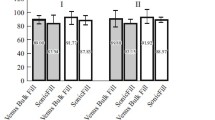Abstract
Various cured binding agent specimens are investigated in order to determine principles of variation of microhardness values of matrix along their thickness. Microhardness measurements of cured binding agent are carried out on cross sections at the load on indenter of microhardness meter of 10 g (0.1 N). The studies show that the microhardness value of the plastic along the thickness of the specimens from the front surface of the specimen to its rear side changes according to a parabolic law with critical microhardness values in the core of the cross section of the semifinished product and direction of the parabolic curve is determined by the type of binder.








Similar content being viewed by others
REFERENCES
A. E. Raskutin, “A strategy for development of polymer composite materials,” Aviats. Mater. Tekhnol., Suppl., 344–348 (2017). https://doi.org/10.18577/2071-9140-2017-0-S-344-348
E. N. Kablov, “Strategic directions of development of materials and technologies of their processing for the period up to 2030,” Aviats. Mater. Tekhnol., Suppl., 7‒17 (2012).
A. E. Raskutin, “Russian polymer composite materials of a new generation, their development, and implementation in promising developed structures,” Aviats. Mater. Tekhnol., Suppl., 349–367 (2017). https://doi.org/10.18577/2071-9140-2017-0-S-349-367
V. A. Il’in, V. I. Postnov, V. V. Semenychev, V. I. Petukhov, and K. E. Nikitin, “The effectiveness of modern science-intensive technologies,” in Aviation Materials. Selected Works. Jubilee Scientific and Technical Collection (VIAM, Moscow, 2007), pp. 413–416 [in Russian].
Armor for Buran. Materials and Technologies of VIAM for ISS Energia-Buran, Ed. by E. N. Kablov (Fond Nauka Zhizn’, Moscow, 2013) [in Russian].
A. S. Mostovoi and A. N. Ledenev, “Modification of epoxy polymers with nanodispersed silicon,” Fiz. Khim. Obrab. Mater., No. 4, 61–66 (2017).
V. M. Aristov and E. P. Aristova, “Influence of structural heterogeneity on the physical properties of partially crystalline polymers,” Plast. Massy, No. 3, 15–17 (2016).
A. A. Platonov, D. I. Kogan, and M. I. Dushin, “Manufacturing of three-dimensional PCMs by impregnation with a film binder,” Plast. Massy, No. 6, 56–61 (2013).
N. A. Lavrov, Sh. N. Kiemov, and V. K. Kryzhanovskii, “Properties of filled epoxy polymers,” Plast. Massy, No. 1, 37–39 (2019).
B. K. Vul’f and K. P. Romadin, Aviation Materials Science (Mashinostroenie, Moscow, 1967) [in Russian].
A. A. Tager, Physicochemistry of Polymers (Nauchn. Mir, Moscow, 2007) [in Russian].
E. A. Veshkin, V. I. Postnov, V. V. Semenychev, and E. V. Krasheninnikova, “Investigation of microhardness and sclerometric characteristics of UP-2227N binder hardened under various modes,” Aviats. Mater. Tekhnol., No. 1, 39–45 (2018). https://doi.org/10.18577/2071-9140-2018-0-1-39-45
E. A. Veshkin, V. I. Postnov, V. V. Semenychev, and E. V. Krasheninnikova, “Microhardness and sclerometry as criteria for the degree of curing of the EDT-69N binder,” Materialovedenie, No. 10, 3–7 (2018). https://doi.org/10.31044/1684-579X-2018-0-10-3-7
C. Weaver, “Adhesion of thin films,” Vac. Sci. Technol. 12, 18 (1975). https://doi.org/10.1116/1.568754
B. N. Fedulov, A. A. Safonov, M. M. Kantor, and S. V. Lomov, “Simulation of curing of thermoplastic composites and estimation of residual stresses,” Kompoz. Nanostrukt. 9 (2), 102–122 (2017).
S. V. Dubinskii, F. S. Sevast’yanov, A. A. Safonov, S. G. Abaimov, N. V. Rozin, and B. N. Fedulov, “A method for calculating the strength properties of structures taking into account the formation of micro and macro pores during vacuum infusion,” Kompoz. Nanostrukt. 8 (3), 151–159 (2016).
V. V. Kudinov, I. K. Krylov, V. I. Mamonov, and N. V. Korneeva, “Fracture of composite materials at low-speed impact,” Fiz. Khim. Obrab. Mater., No. 3, 66–71 (2018). https://doi.org/10.30791/0015-3214-2018-3-66-71
GOST (State Standard) 9450–76: Measuring Microhardness by Indentation of Diamond Tips (1976).
A. D. Kuritsyna, “Application of the microhardness method to determine some properties of polymer materials,” in Microhardness Testing Methods (Nauka, Moscow, 1965) [in Russian].
E. A. Veshkin, V. I. Postnov, V. V. Semenychev, E. V. Krasheninnikova, and V. V. Ershov, “Evaluation of the kinetics of curing of polyester resin in time by standard and non-standard methods,” Plast. Massy, Nos. 11–12, 42–46 (2018).
E. A. Veshkin, V. I. Postnov, V. V. Semenychev, and E. V. Krasheninnikova, “Anisotropic properties of cured binders,” Polym. Sci., Ser. D 12, 5–8 (2019). https://doi.org/10.31044/1813-7008-2018-0-8-20-24
L. F. Kalistratova and V. A. Egorova, “Ordering of the amorphous phase as one of the characteristics of the supramolecular structure of an amorphous crystalline polymer,” Materialovedenie, No. 1, 3–8 (2019).
E. N. Kablov, “Innovations of the All-Russian Institute of Aviation Materials (VIAM) as part of implementing the Strategic Directions of Development of Materials and Technologies of Their Processing for the Period up to 2030,” Aviats. Mater. Tekhnol., No. 1, 3–33 (2015). https://doi.org/10.18577/2071-9140-2015-0-1-3-33
Author information
Authors and Affiliations
Corresponding author
Ethics declarations
The authors declare that they have no conflicts of interest.
Additional information
Translated by A. Muravev
Rights and permissions
About this article
Cite this article
Veshkin, E.A., Postnov, V.I. & Semenychev, V.V. A Method for Evaluating the Change of Matrix Characteristics in Bulk Polymer Composites. Polym. Sci. Ser. D 14, 80–85 (2021). https://doi.org/10.1134/S1995421221010251
Received:
Revised:
Accepted:
Published:
Issue Date:
DOI: https://doi.org/10.1134/S1995421221010251




